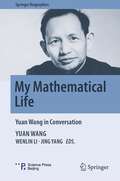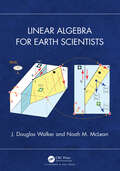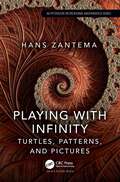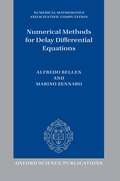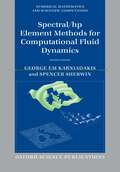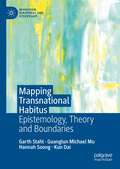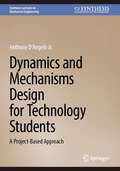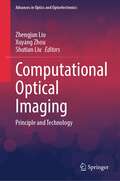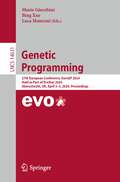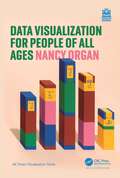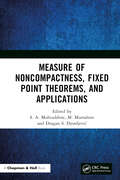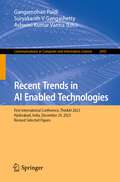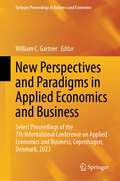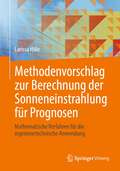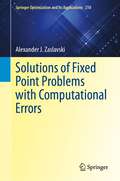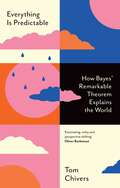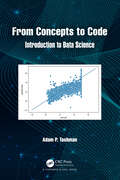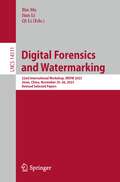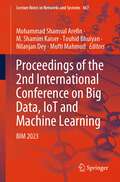- Table View
- List View
My Mathematical Life: Yuan Wang in Conversation (Springer Biographies)
by Yuan WangThis book is an autobiographical interview with Chinese Academician Yuan Wang on his experience in mathematical research. The book looks back on Wang's collaboration with his teacher Hua Loo-Keng and younger scholars, offering insights into fruitful cooperation in mathematical research.In this book, Yuan Wang’s path of studying Goldbach conjecture is revealed in detail from motivation to method. Then his work on algebraic number theory is traced back in a separate chapter. The book ends with two chapters which introduce Wang’s interest in history of mathematics and his hobbies outside of mathematical research. Wang shows how a mathematician can in the same time be a historical and popular science writer and, in particular, a well-received calligrapher. The book is intended for undergraduate and graduate students studying number theory. Researchers who are willing to learn from the experience of an established mathematician, as well as math amateurs and general audience who are interested in Yuan Wang's life story might also find this book appealing.
Linear Algebra for Earth Scientists
by J. Douglas Walker Noah M. McLeanLinear Algebra for Earth Scientists is written for undergraduate and graduate students in Earth and Environmental sciences. It is intended to give students enough background in linear algebra to work with systems of equations and data in geology, hydrology, geophysics, or whatever part of the Earth Sciences they engage with.The book does not presuppose any extensive prior knowledge of linear algebra. Instead, the book builds students up from a low base to a working understanding of the sub t that they can apply to their work, using many familiar examples in the geosciences.Features Suitable for students of Earth and Environmental Sciences Minimal prerequisites — written in a way that is accessible and engaging for those without a mathematical background All material presented with examples and applications to the Earth Sciences
Linear Algebra for Earth Scientists
by J. Douglas Walker Noah M. McLeanLinear Algebra for Earth Scientists is written for undergraduate and graduate students in Earth and Environmental sciences. It is intended to give students enough background in linear algebra to work with systems of equations and data in geology, hydrology, geophysics, or whatever part of the Earth Sciences they engage with.The book does not presuppose any extensive prior knowledge of linear algebra. Instead, the book builds students up from a low base to a working understanding of the sub t that they can apply to their work, using many familiar examples in the geosciences.Features Suitable for students of Earth and Environmental Sciences Minimal prerequisites — written in a way that is accessible and engaging for those without a mathematical background All material presented with examples and applications to the Earth Sciences
Playing with Infinity: Turtles, Patterns, and Pictures (AK Peters/CRC Recreational Mathematics Series)
by Hans ZantemaThis is a book about infinity - specifically the infinity of numbers and sequences. Amazing properties arise, for instance, some kinds of infinity are argued to be greater than others. Along the way the author will demonstrate how infinity can be made to create beautiful ‘art’, guided by the development of underlying mathematics. This book will provide a fascinating read for anyone interested in number theory, infinity, math art, and/or generative art, and could be used a valuable supplement to any course on these topics.Features: Beautiful examples of generative art Accessible to anyone with a reasonable high school level of mathematics Full of challenges and puzzles to engage readers
Playing with Infinity: Turtles, Patterns, and Pictures (AK Peters/CRC Recreational Mathematics Series)
by Hans ZantemaThis is a book about infinity - specifically the infinity of numbers and sequences. Amazing properties arise, for instance, some kinds of infinity are argued to be greater than others. Along the way the author will demonstrate how infinity can be made to create beautiful ‘art’, guided by the development of underlying mathematics. This book will provide a fascinating read for anyone interested in number theory, infinity, math art, and/or generative art, and could be used a valuable supplement to any course on these topics.Features: Beautiful examples of generative art Accessible to anyone with a reasonable high school level of mathematics Full of challenges and puzzles to engage readers
Numerical Methods for Delay Differential Equations (Numerical Mathematics and Scientific Computation)
by Alfredo Bellen Marino ZennaroThe main purpose of the book is to introduce the readers to the numerical integration of the Cauchy problem for delay differential equations (DDEs). Peculiarities and differences that DDEs exhibit with respect to ordinary differential equations are preliminarily outlined by numerous examples illustrating some unexpected, and often surprising, behaviours of the analytical and numerical solutions. The effect of various kinds of delays on the regularity of the solution is described and some essential existence and uniqueness results are reported. The book is centered on the use of Runge-Kutta methods continuously extended by polynomial interpolation, includes a brief review of the various approaches existing in the literature, and develops an exhaustive error and well-posedness analysis for the general classes of one-step and multistep methods. The book presents a comprehensive development of continuous extensions of Runge-Kutta methods which are of interest also in the numerical treatment of more general problems such as dense output, discontinuous equations, etc. Some deeper insight into convergence and superconvergence of continuous Runge-Kutta methods is carried out for DDEs with various kinds of delays. The stepsize control mechanism is also developed on a firm mathematical basis relying on the discrete and continuous local error estimates. Classical results and a unconventional analysis of "stability with respect to forcing term" is reviewed for ordinary differential equations in view of the subsequent numerical stability analysis. Moreover, an exhaustive description of stability domains for some test DDEs is carried out and the corresponding stability requirements for the numerical methods are assessed and investigated. Alternative approaches, based on suitable formulation of DDEs as partial differential equations and subsequent semidiscretization are briefly described and compared with the classical approach. A list of available codes is provided, and illustrative examples, pseudo-codes and numerical experiments are included throughout the book.
Spectral/hp Element Methods for Computational Fluid Dynamics: Second Edition (Numerical Mathematics and Scientific Computation)
by George Karniadakis Spencer SherwinSpectral methods have long been popular in direct and large eddy simulation of turbulent flows, but their use in areas with complex-geometry computational domains has historically been much more limited. More recently the need to find accurate solutions to the viscous flow equations around complex configurations has led to the development of high-order discretisation procedures on unstructured meshes, which are also recognised as more efficient for solution of time-dependent oscillatory solutions over long time periods. Here Karniadakis and Sherwin present a much-updated and expanded version of their successful first edition covering the recent and significant progress in multi-domain spectral methods at both the fundamental and application level. Containing over 50% new material, including discontinuous Galerkin methods, non-tensorial nodal spectral element methods in simplex domains, and stabilisation and filtering techniques, this text aims to introduce a wider audience to the use of spectral/hp element methods with particular emphasis on their application to unstructured meshes. It provides a detailed explanation of the key concepts underlying the methods along with practical examples of their derivation and application, and is aimed at students, academics and practitioners in computational fluid mechanics, applied and numerical mathematics, computational mechanics, aerospace and mechanical engineering and climate/ocean modelling.
Mapping Transnational Habitus: Epistemology, Theory and Boundaries (Migration, Diasporas and Citizenship)
by Garth Stahl Guanglun Michael Mu Hannah Soong Kun DaiThis book surveys and critiques existing empirical and theoretical literature on the Bourdieu-informed concept of transnational habitus. The term "transnational” has been used widely in studies of migration research where it has allowed scholars to have a deeper understanding of the practices not only of migrants moving across national borders but also of agents taking positions in transnational spaces without necessarily criss-crossing different nation states. Focusing on the potential of transnational habitus as an analytical tool, the authors propose a model of transnational habitus to identify integral key factors for the operationalisation in research. Drawing on reflexivity, the authors analyse transnational selves and map transnational spaces of classification. Identifying strengths, inconsistencies and key problems in this rapidly developing body of literature, this interdisciplinary and international book will be of interest to students and scholars in sociology, anthropology, migration studies, cultural studies, human geography, as well as diaspora studies.
Dynamics and Mechanisms Design for Technology Students: A Project-Based Approach (Synthesis Lectures on Mechanical Engineering)
by Anthony D´Angelo Jr.The book reviews the algebra, trigonometry, and basic calculus students need to be successful in solving problems. Next, a review of kinematics and Newton’s laws are discussed, and numerous examples are solved. Mechanisms include the slider crank, offset slider crank, gears and gear trains, belts and chains, and cams. A graphical and analytical approach is taken when covering slider crank mechanisms. The book uses vectors and Kennedy's theorem to solve a variety of included examples. Gears and gear trains as well as belts and chains are discussed. Finally, cams using graphical and analytical techniques are introduced. The concluding chapter gives multiple projects used in the class to capture the lectures and computer modeling using Excel and MATLAB.
Computational Optical Imaging: Principle and Technology (Advances in Optics and Optoelectronics)
by Zhengjun Liu Xuyang Zhou Shutian LiuThis book highlights a comprehensive introduction to the principles and calculation methods of computational optical imaging. Integrating optical imaging and computing technology to achieve significant performance improvements, computational optical imaging has become an active research field in optics. It has given rise to the emerging of new concepts such as computational imaging, computational measurement and computational photography. As high-performance image detectors make image measurements discrete and digital, images are mostly recorded in the form of discrete data, almost replacing the continuous medium used for pattern recording. Computational optical imaging technology has become an effective way for people to study microscopic imaging. At present, different imaging systems are composed of continuous optical elements such as lenses and prisms or discrete optical elements such as spatial light modulators or digital micro-mirror devices. The current computing technology has permeated all aspects of imaging systems and gradually promotes the digitization of optical imaging systems. This book summarizes the representative work done in this field and introduces the latest results. Computing technology plays an important bridging role between theories of optics and experimental systems, which inspires more comprehensive and in-depth research. It has the advantages of high repeatability, flexibility, strong computing power and low cost. In this multidisciplinary field, researchers in computer science, optics and information science have joined together to extend its depth and breadth. Targeting cutting-edge issues to be solved in computational optics, this book introduces a variety of methods that involve theoretical innovations and technical breakthroughs in imaging resolution, the field of view, imaging speed, and computing speed. It intends to provide a handy reference and technical support for graduate students, researchers and professionals engaged in the study and practice of computational optical imaging.
Mathematics class 7 - MIE
by Mauritius Institute of EducationThe Grade 7 Mathematics textbook, authored by Professor Vassen Naëck and a team from the Mauritius Institute of Education, serves as a vital resource in aligning with the National Curriculum Framework, guiding students through a seamless transition from Grade 6 to secondary education. Its comprehensive content spans Numbers, Algebra, Measures, Geometry, and Probability + Statistics, emphasizing problem-solving and real-world applications. Utilizing a pedagogical approach that prioritizes sense-making and reasoning, the textbook integrates digital tools like GeoGebra to deepen understanding. With various icons highlighting activities, exercises, and notes, the text promotes interactive and engaging learning experiences, fostering a deeper comprehension of mathematical concepts.
Genetic Programming: 27th European Conference, EuroGP 2024, Held as Part of EvoStar 2024, Aberystwyth, UK, April 3–5, 2024, Proceedings (Lecture Notes in Computer Science #14631)
by Mario Giacobini Bing Xue Luca ManzoniThis book constitutes the refereed proceedings of the 27th European Conference on Genetic Programming, EuroGP 2024, held in Aberystwyth, UK, April 3–5, 2024 and co-located with the EvoStar events, EvoCOP, EvoMUSART, and EvoApplications.The 13 papers (9 selected for long presentation and 4 for short presentation) collected in this book were carefully reviewed and selected from 24 submissions. The wide range of topics in this volume reflects the current state of research in the field. The collection of papers cover topics including developing new variants of GP algorithms, as well as exploring GP applications to the optimization of machine learning methods and the evolution of control policies.
Data Visualization for People of All Ages (ISSN)
by Nancy OrganData visualization is the art and science of making information visible. On paper and in our imaginations, it’s a language of shapes and colors that holds our best ideas and most important questions. As we find ourselves swimming in data of all kinds, visualization can help us to understand, express, and explore the richness of the world around us. No matter your age or background, this book opens the door to new ways of thinking and sharing through the power of data visualization.Data Visualization for People of All Ages is a field guide to visual literacy, born from the author’s personal experience working with world-class scholars, engineers, and scientists. By walking through the different ways of showing data—including color, angle, position, and length—you’ll learn how charts and graphs truly work so that no visualization is ever a mystery or out of reach. It doesn’t stop at what fits on a page, either. You’ll journey into cutting-edge topics like data sonification and data physicalization, using sound and touch to share data across the different senses. Packed with practical examples and exercises to help you connect the dots, this book will teach you how to create and understand data visualizations on your own—all without writing a single line of code or getting tangled up in software.Written with accessibility in mind, this book invites everyone to the table to share the joy of one of today’s most necessary skills. Perfect for home or classroom use, this friendly companion gives people of all ages everything they need to start visualizing with confidence.
Data Visualization for People of All Ages (ISSN)
by Nancy OrganData visualization is the art and science of making information visible. On paper and in our imaginations, it’s a language of shapes and colors that holds our best ideas and most important questions. As we find ourselves swimming in data of all kinds, visualization can help us to understand, express, and explore the richness of the world around us. No matter your age or background, this book opens the door to new ways of thinking and sharing through the power of data visualization.Data Visualization for People of All Ages is a field guide to visual literacy, born from the author’s personal experience working with world-class scholars, engineers, and scientists. By walking through the different ways of showing data—including color, angle, position, and length—you’ll learn how charts and graphs truly work so that no visualization is ever a mystery or out of reach. It doesn’t stop at what fits on a page, either. You’ll journey into cutting-edge topics like data sonification and data physicalization, using sound and touch to share data across the different senses. Packed with practical examples and exercises to help you connect the dots, this book will teach you how to create and understand data visualizations on your own—all without writing a single line of code or getting tangled up in software.Written with accessibility in mind, this book invites everyone to the table to share the joy of one of today’s most necessary skills. Perfect for home or classroom use, this friendly companion gives people of all ages everything they need to start visualizing with confidence.
Measure of Noncompactness, Fixed Point Theorems, and Applications
by S. A. Mohiuddine M. Mursaleen Dragan S. DjordjevićThe theory of the measure of noncompactness has proved its significance in various contexts, particularly in the study of fixed point theory, differential equations, functional equations, integral and integrodifferential equations, optimization, and others. This edited volume presents the recent developments in the theory of the measure of noncompactness and its applications in pure and applied mathematics. It discusses important topics such as measures of noncompactness in the space of regulated functions, application in nonlinear infinite systems of fractional differential equations, and coupled fixed point theorem.Key Highlights: Explains numerical solution of functional integral equation through coupled fixed point theorem, measure of noncompactness and iterative algorithm Showcases applications of the measure of noncompactness and Petryshyn’s fixed point theorem functional integral equations in Banach algebra Explores the existence of solutions of the implicit fractional integral equation via extension of the Darbo’s fixed point theorem Discusses best proximity point results using measure of noncompactness and its applications Includes solvability of some fractional differential equations in the holder space and their numerical treatment via measures of noncompactness This reference work is for scholars and academic researchers in pure and applied mathematics.
Measure of Noncompactness, Fixed Point Theorems, and Applications
The theory of the measure of noncompactness has proved its significance in various contexts, particularly in the study of fixed point theory, differential equations, functional equations, integral and integrodifferential equations, optimization, and others. This edited volume presents the recent developments in the theory of the measure of noncompactness and its applications in pure and applied mathematics. It discusses important topics such as measures of noncompactness in the space of regulated functions, application in nonlinear infinite systems of fractional differential equations, and coupled fixed point theorem.Key Highlights: Explains numerical solution of functional integral equation through coupled fixed point theorem, measure of noncompactness and iterative algorithm Showcases applications of the measure of noncompactness and Petryshyn’s fixed point theorem functional integral equations in Banach algebra Explores the existence of solutions of the implicit fractional integral equation via extension of the Darbo’s fixed point theorem Discusses best proximity point results using measure of noncompactness and its applications Includes solvability of some fractional differential equations in the holder space and their numerical treatment via measures of noncompactness This reference work is for scholars and academic researchers in pure and applied mathematics.
Recent Trends in AI Enabled Technologies: First International Conference, ThinkAI 2023, Hyderabad, India, December 29, 2023, Revised Selected Papers (Communications in Computer and Information Science #2045)
by Gangamohan Paidi Suryakanth V Gangashetty Ashwini Kumar VarmaThis book constitutes the refereed proceedings of the First International Conference on Recent Trends in AI Enabled Technologies, ThinkAI 2023, which took place in Hyderabad, India, in December 2023. The 7 full papers presented in these proceedings were carefully reviewed and selected from 51 submissions. The conference focuses on on up to date topics and recent trends in artificial intelligence and related technologies.
New Perspectives and Paradigms in Applied Economics and Business: Select Proceedings of the 7th International Conference on Applied Economics and Business, Copenhagen, Denmark, 2023 (Springer Proceedings in Business and Economics)
by William C. GartnerThis book features a collection of high-quality and peer-reviewed papers from the 2023 7th International Conference on Applied Economics and Business, which was held in Copenhagen, Denmark, during August 24-26, 2023. ICAEB is held annually as a platform for the presentation of new advances and research results in the fields of applied economics and business. Applied economics is a way of dealing with esoteric economic concepts in a practical and analytical way. It allows for decisions to be made that are underlined by theoretical economic principles but utilized in such a way that they transform into real work applications.The contributors cover topics such as environment, development, finance, forensics, information, institutions, international, labor, management, mathematics, currency, tourism and many more. Applied Economics affects all aspects of life and science and it is brought to the forefront in this collection of papers. The conference, with its aim to bring together economists from different fields, lends itself to a natural and rich collection of scientific papers all focused on the practical application of economic principles. The scope of this collection of papers will be useful to academics and practitioners who look to economics to help solve problems.
Methodenvorschlag zur Berechnung der Sonneneinstrahlung für Prognosen: Mathematische Verfahren für die ingenieurtechnische Anwendung
by Larissa HilleUm eine effiziente Nutzung erneuerbarer Energien zu ermöglichen, werden zuverlässige Prognosen für die Intensität der Sonneneinstrahlung benötigt. Im ersten Teil dieses Buchs wird eine neue, effiziente Methode für die Berechnung der diffusen Strahlung vorgestellt. Sie bestimmt die Intensität des gestreuten Lichts in einer Umgebung mit einer vertikal und horizontal variierenden Anzahldichte der streuenden Partikel. Die Methode kombiniert Monte-Carlo-Simulationen mit der Integralrechnung. Sie ermöglicht das Wiederverwenden berechneter Ergebnisse und erfordert bei einer vielfachen Anwendung einen geringen Rechenaufwand. Im zweiten Teil dieses Buchs wird eine einfache und genaue Methode zur Berechnung der Sonnenposition beschrieben. Die Methode basiert auf dem zweiten Keplerschen Gesetz und verwendet eine exakte trigonometrische Formel für die Fläche eines Ellipsensektors.
Solutions of Fixed Point Problems with Computational Errors (Springer Optimization and Its Applications #210)
by Alexander J. ZaslavskiThe book is devoted to the study of approximate solutions of fixed point problems in the presence of computational errors. It begins with a study of approximate solutions of star-shaped feasibility problems in the presence of perturbations. The goal is to show the convergence of algorithms, which are known as important tools for solving convex feasibility problems and common fixed point problems.The text also presents studies of algorithms based on unions of nonexpansive maps, inconsistent convex feasibility problems, and split common fixed point problems. A number of algorithms are considered for solving convex feasibility problems and common fixed point problems. The book will be of interest for researchers and engineers working in optimization, numerical analysis, and fixed point theory. It also can be useful in preparation courses for graduate students. The main feature of the book which appeals specifically to this audience is the study of the influence of computational errorsfor several important algorithms used for nonconvex feasibility problems.
Everything Is Predictable: How Bayes' Remarkable Theorem Explains the World
by Tom ChiversThomas Bayes was an eighteenth-century Presbyterian minister and amateur mathematician whose obscure life belied the profound impact of his work. Like most research into probability at the time, his theorem was mainly seen as relevant to games of chance, like dice and cards. But its implications soon became clear. Bayes' theorem helps explain why highly accurate screening tests can lead to false positives, causing unnecessary anxiety for patients. A failure to account for it in court has put innocent people in jail. But its influence goes far beyond practical applications. A cornerstone of rational thought, Bayesian principles are used in modelling and forecasting. 'Superforecasters', a group of expert predictors who outperform CIA analysts, use a Bayesian approach. And many argue that Bayes' theorem is not just a useful tool, but a description of almost everything - that it is the underlying architecture of rationality, and of the human brain. Fusing biography, razor-sharp science communication and intellectual history, Everything Is Predictable is a captivating tour of Bayes' theorem and its impact on modern life. From medical testing to artificial intelligence, Tom Chivers shows how a single compelling idea can have far-reaching consequences.
From Concepts to Code: Introduction to Data Science
by Adam P. TashmanThe breadth of problems that can be solved with data science is astonishing, and this book provides the required tools and skills fot a broad audience. The reader takes a journey into the forms, uses, and abuses of data and models, and learns how to critically examine each step. Python coding and data analysis skills are built from the ground up, with no prior coding experience assumed. The necessary background in computer science, mathematics, and statistics is provided in an approachable manner.Each step of the machine learning lifecycle is discussed, from business objective planning to monitoring a model in production. This end-to-end approach supplies the broad view necessary to sidestep many of the pitfalls that can sink a data science project. Detailed examples are provided from a wide range of applications and fields, from fraud detection in banking to breast cancer classification in healthcare. The reader will learn the techniques to accomplish tasks that include predicting outcomes, explaining observations, and detecting patterns. Improper use of data and models can introduce unwanted effects and dangers to society. A chapter on model risk provides a framework for comprehensively challenging a model and mitigating weaknesses. When data is collected, stored, and used, it may misrepresent reality and introduce bias. Strategies for addressing bias are discussed. From Concepts to Code: Introduction to Data Science leverages content developed by the author for a full-year data science course suitable for advanced high school or early undergraduate students. This course is freely available and it includes weekly lesson plans.
From Concepts to Code: Introduction to Data Science
by Adam P. TashmanThe breadth of problems that can be solved with data science is astonishing, and this book provides the required tools and skills fot a broad audience. The reader takes a journey into the forms, uses, and abuses of data and models, and learns how to critically examine each step. Python coding and data analysis skills are built from the ground up, with no prior coding experience assumed. The necessary background in computer science, mathematics, and statistics is provided in an approachable manner.Each step of the machine learning lifecycle is discussed, from business objective planning to monitoring a model in production. This end-to-end approach supplies the broad view necessary to sidestep many of the pitfalls that can sink a data science project. Detailed examples are provided from a wide range of applications and fields, from fraud detection in banking to breast cancer classification in healthcare. The reader will learn the techniques to accomplish tasks that include predicting outcomes, explaining observations, and detecting patterns. Improper use of data and models can introduce unwanted effects and dangers to society. A chapter on model risk provides a framework for comprehensively challenging a model and mitigating weaknesses. When data is collected, stored, and used, it may misrepresent reality and introduce bias. Strategies for addressing bias are discussed. From Concepts to Code: Introduction to Data Science leverages content developed by the author for a full-year data science course suitable for advanced high school or early undergraduate students. This course is freely available and it includes weekly lesson plans.
Digital Forensics and Watermarking: 22nd International Workshop, IWDW 2023, Jinan, China, November 25–26, 2023, Revised Selected Papers (Lecture Notes in Computer Science #14511)
by Bin Ma Jian Li Qi LiThis book constitutes the refereed post proceedings of the 22nd International Workshop on Digital Forensics and Watermarking, IWDW 2023, held in Jinan, China, during November 25–26, 2023. The 22 full papers included in this book were carefully reviewed and selected from 48 submissions. The workshop focuses on subjects such as novel research, development and application of digital watermarking, data hiding, and forensic techniques for multimedia security.
Proceedings of the 2nd International Conference on Big Data, IoT and Machine Learning: BIM 2023 (Lecture Notes in Networks and Systems #867)
by Mohammad Shamsul Arefin M. Shamim Kaiser Touhid Bhuiyan Nilanjan Dey Mufti MahmudThis book gathers a collection of high-quality peer-reviewed research papers presented at the International Conference on Big Data, IoT and Machine Learning (BIM 2023), organised by Jahangirnagar University, Bangladesh, and Daffodil International University, Bangladesh, held in Dhaka, Bangladesh, during 6–8 September 2023. The book covers research papers in the field of big data, IoT and machine learning. The book is helpful for active researchers and practitioners in the field.
